New to homeschooling this year? Trying to find a daily homeschool schedule for kindergarten that works for your family? In this post, I share about my successes and failures with homeschooling kindergarten. At the bottom, you’ll find some sample daily routines as well as an editable kindergarten schedule template.
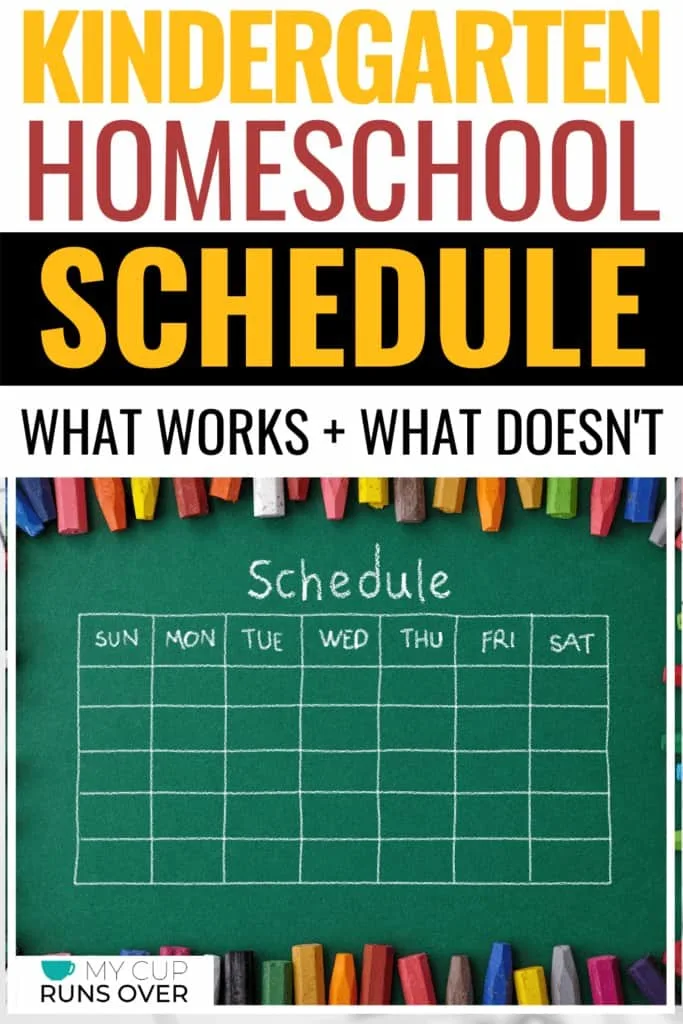
Kindergarten might be one of the easier grades to homeschool, but it also has the privilege of being one of the most daunting, because it’s often the year families make the decision to start homeschooling.
In other words, kindergarten is the grade where parents start to freak out and wonder whether they have what it takes to teach their children at home.
Don’t worry!
With a daily homeschool schedule for kindergarten and a basic routine, you and your child will survive kindergarten with flying colors!
How Our Kindergarten Routines Have Changed Over the Years
Nine years ago, on my eldest daughter’s fifth birthday, I pulled her and her three-and-a-half-year-old sister out of daycare and started homeschooling them.
It wasn’t a rash decision. Nothing bad had happened at daycare or anything like that. In fact, I’d been preparing for that moment for months, having given my notice at work exactly half a year earlier.
And yet.
Suddenly I went from being a full-time work-out-of-the-home mom to a full-time stay-at-home homeschooler with no support network and no clue what I was doing. At the time, I didn’t even know anyone else who homeschooled, though I would soon learn that I lived in a region teeming with home learners.
I did no research into curriculum, teaching methods, strategies, routines, or anything like that. Seriously.

Here’s what I did do: I learned what the requirements were in my province, registered through a local independent school, bought a few workbooks at Costco, and downloaded whatever activity suggestions the school sent my way (which, in hindsight, were probably too many).
We passed the whole first year that way, and though personal and family circumstances made it one of the most difficult years of our lives, our homeschool thrived.
We were creative. We were flexible. We were curious.
We allowed our inquisitiveness and inspiration to guide us.
We went to the library all the time, made a homemade worm composter, went skating with an elderly couple from our church every week, and made movies out of the books we read.
Oh, and we drove across Canada!

The Introduction of Curriculum, Schedules, and Routines
Toward the end of that year, I met the most amazing veteran homeschooling mom and she gave me a book that I still consider the ultimate authority on choosing homeschool curricula.
I devoured it. Oh my word. I read it front to back and then back to front.
I filled out every quiz and exercise and made charts comparing every tantalizing curriculum in the book. (There were, oh I don’t know, 102?)
I couldn’t believe how horribly wrong I’d gone in that first year. How much we’d missed out on! How was I ever going to catch up?
Then I attended my first curriculum fair with a PO number in hand and spent hundreds of dollars on books. For my four and six-year-olds!

Over the next couple of years, I completely abandoned our relaxed homeschooling style in favor of a curriculum-led approach.
Now, please don’t misunderstand me.
I LOVE CURRICULUM.
I really do. Even today, if you set me loose in a school gym filled with curriculum vendor booths, I would need a wagon to carry home all the books I wouldn’t be able to resist.
But I went overboard.
Not only did I kill the creativity and joy in our homeschool, but I also squashed my intuition as a homeschool mother. I felt that if I didn’t do everything the homeschool schedule and books said I had to do, I was failing my kids. I forgot how to listen to my own instinct and structure my kids’ learning in the best way for them.
Re-establishing Balance in our Kindergarten Homeschool Schedule
One benefit of homeschooling in a large family is that you get so many opportunities for do-overs, countless chances to make things better.
I’ve now successfully homeschooled three kids through kindergarten and have another one who’s quickly approaching that age, and I think I’ve managed to find a balanced approach to homeschool planning.
In our homeschool kindergarten, we use curriculum, but not too much. We use a daily schedule, and we try to stick to it, but we also make room for flexibility.
I don’t want to be the mother who interrupts her child’s engaged learning because the schedule says it’s time to move onto something else.

The most important thing to remember when planning your kindergarten homeschool schedule is this:
The schedule is there to serve you, not the other way around.
What You Need to Think About When Planning Your Homeschool Schedule
With that in mind, I’d like to help you think about what your daily kindergarten homeschool schedule might look like.
Every family is unique, and what works for one family may not work for another, so I’ll guide you through all the things I think about when I do my homeschool schedule planning. (As an aside, though we set our schedule template at the beginning of the year, I make updates to our weekly schedule every Saturday night to take into account the commitments of the upcoming week).
Requirements of Your State or Province
Each state and province (in the US and Canada, anyway) has its own legislation around homeschooling, and it’s a good idea to check in with that to see what is required of you.
Some jurisdictions are quite open-ended about what your life as a homeschooler should look like, and others are more particular.
You may be expected to prove that you provided formal education to your children for a minimum number of hours and/or days throughout the year. You may also need to provide evidence of the content you covered and ensure you’re teaching all of the required subjects.
So, even if your natural inclination is to be schedule-free, having at least some basic outline of your day and the content you’re covering is going to save you a lot of headaches when it comes time to report on your progress.

Take some time to learn more about the homeschool laws in your state or province.
How Much Time You Have Available
One of the best books I’ve read about homeschool planning is Sarah Mackenzie’s Teaching from Rest (Read my review here). Now, I like to think of myself as a relatively organized person. I know how to get things done. I can create a schedule or routine with the best of them.
But for some reason, it wasn’t until I read this book that I actually managed to feel organized and on top of things in my homeschool.
The biggest takeaway I got from the book is that you have to treat your homeschool schedule the way you treat a family budget.
You would never create your family budget by listing every single thing you want to buy, setting an aspirational value for each item, and declaring that your income must somehow be able to incorporate everything you desire.

So why do we treat time differently?
It’s a finite resource, much more so than money. We can’t make any additional time.
So why do we approach homeschool planning with a list of subjects, determine an amount of time we should dedicate to each one, and expect our days to somehow be able to hold everything in?
Something has to give.
It seems like a simple principle, but I actually spent about seven years planning my homeschool that way and wondering why we were never able to get everything done by the end of the year.
Now, however, we start with the amount of time we have available. Then we ask some simple questions, like how much time do you want to spend homeschooling each day? What else do you have to do?
How much time do you want to spend homeschooling each day? What else do you have to do?
Are you working part-time? Full-time? Do you or your kids have activities and commitments outside of the house?
How much time do you want to set aside for things like faith-based activities, prepping and eating meals, housework, free play, outside time, hygiene, and sleep?
When I create our calendar, I start with all of these things, and I fit “homeschooling” into the remaining chunks of time. I use the term homeschooling loosely to refer to the specific planned educational training we do through online or literature-based programs.
Of course, learning is happening at home ALL of the time, and perhaps most often so when we are not working on such programs.
When I approach my schedule in this way, I have about four-and-a-half hours day from Monday to Thursday and about three hours on Friday in which to help my four kids with their planned learning activities. It’s a lot less than I used to think I needed, but it works, and it’s sustainable.
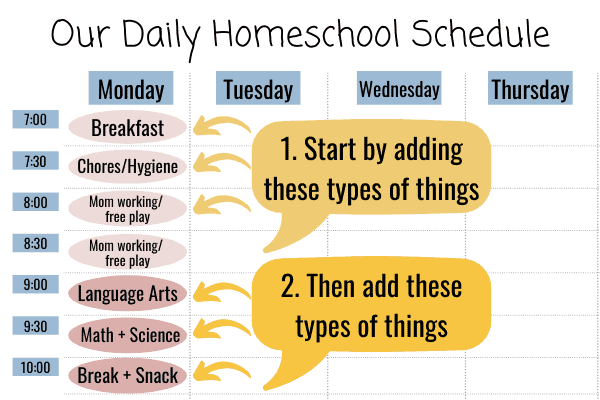
How Much of that Time is Spent on Kindergarten Hours?
I would say that I spent about one to one-and-a-half hours a day of hands on time with my kindergartener last year, and she did another 30-40 minutes on her own using a couple of educational apps.
Keep in mind, as you’ll read below, that most of the time we’re working together, it’s me reading stories to her while she plays, draws, or creates something. It’s not her filling in worksheets or doing any kind of writing at all beyond a copywork sentence here and there.

Kindergarten Subjects and Homeschool Curriculum
As I learned in my first “ignorant” year of homeschooling, it’s not always necessary to have formal curricula in your homeschool, especially in the early years. (Here’s a post on how you can homeschool most subjects without any curriculum at all).
However, it is important to have some kind of plan and know what you’re hoping to accomplish in the year, and how you might go about doing it.
While we could easily homeschool kindergarten without the use of curriculum, because we have multiple children working at different grade levels I find it’s best for my own sanity to use a handful of programs that I can just pick up and use straight out of the box without any prep work at all.
My third daughter, who just finished kindergarten, is also my first child who has had screen time incorporated into her education from day one. Again, this came as a necessity of her birth order.

She was ready to learn faster than I was able to keep up with her, and I needed the help of a few apps to make that possible for her.
The last thing I want to do is stand in the way of a child who wants to learn more!
Here’s a quick list of the books and apps we used for kindergarten last year:
History/Geography/Bible/Literature: Sonlight A.
Now, after hearing me say how little time I have, you might think it’s funny that I chose a homeschool program that requires so much hands-on time from the parent. And you wouldn’t be wrong in wondering about that!
However, over the years we have found time and time again that reading aloud with our kids is the number one most enjoyable thing about our homeschool.
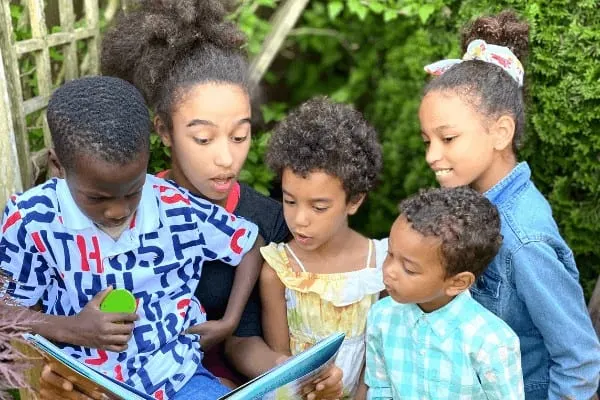
We love sharing in rich literature experiences, learning about other cultures, and building bonds and memories based on books. We love that learning is taking place, even though it feels more like entertainment, and we love how so many of these stories go on to become family classics.
And Sonlight just has a reputation for picking some of the best stories. So, we usually incorporate Sonlight into our curriculum planning and we spend about half our time just reading these living books. We don’t always read every single one of the books, but we do as many as we can! This remains a highlight in the day of all my kids.
Math: MathSeeds
With my first two children, I used Singapore Math for several years, and though it’s an excellent program that gave them a firm mathematical foundation, we found it very time-consuming and relatively unengaging.
With my third daughter, we used the Mathseeds app, which is the sister program to Reading Eggs. We started her on this when she was four and she absolutely loved it. She has since moved onto CTCMath and then to Teaching Textbooks, and she’s working a few years ahead thanks to the strong start she got with MathSeeds.
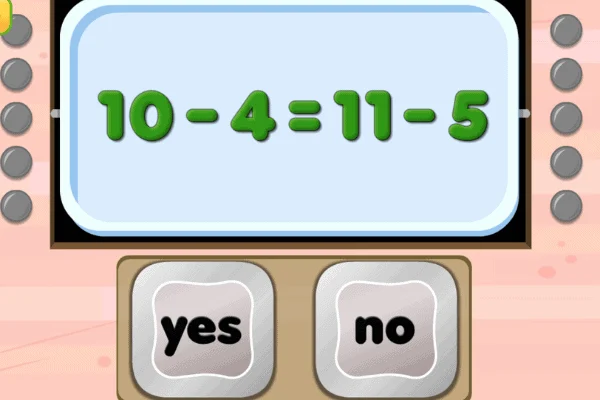
Reading: Reading Eggs
Again, time became the number one factor in choosing a reading program once we had several young children in the house.
With my older kids, I used Sidney Ledson’s book, Teach Your Child to Read in Just Ten Minutes a Day. I made homemade flashcards and games and spent so. much. time. (much more than ten minutes a day) prepping new activities for them to do. (That’s not that book’s fault; that’s me being an overachiever). And it worked. They learned to read early and still love reading.
But that just wasn’t an option with the younger two, so we used Reading Eggs with them and achieved similar or better results in less time, with way less effort on my part.
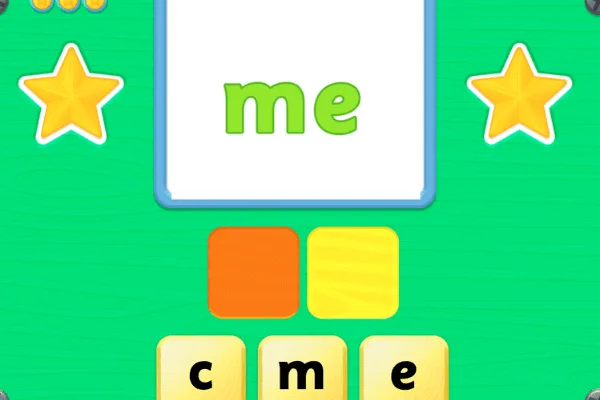
Science: Exploring Creation Series + Teacher’s Pay Teachers
I was very fortunate to have an amazing friend teach my kids science last year. A former high school science teacher turned homeschooler, she created amazing co-ops for them that were not only engaging but checked off a bunch of provincial learning outcomes too. (Hooray!)
For our older kids, we were using Apologia’s Exploring Creation with Physics and Chemistry, so we got the kindergarteners copies of the Junior Notebooking Journals and they followed along with that for one term (they only did age-appropriate activities such as experiments. They did not write in the journals themselves at this age).
In the other two terms, my friend purchased inexpensive units on Motion/Energy and The Ocean from Teachers Pay Teachers. Once a week the kids did a short lesson, watched a video, and did an experiment.
If it were not for my organized, science-loving friend, however, I think me and my girl would just be poking around in the backyard, digging stuff up, identifying insects, plants and birds, and giving ourselves a big old check in the kindergarten science box.
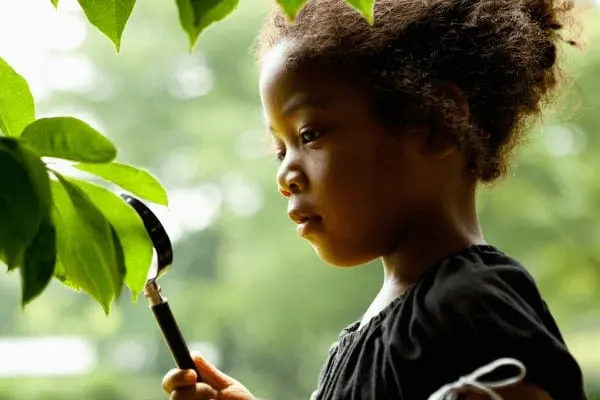
Other Things to Include in Your Daily Routine for Kindergarten
In addition to the subjects mentioned above (or those required by your jurisdiction), there are several other things you’ll want to make room for you in your schedule.
These include:
- Field trips (both formal, like to a museum, and informal, such as the library)
- Time to do tasks and chores around the house
- Hands-on activities (Our Sonlight curriculum comes with some awesome hands-on history activities and science labs, and they take precedence in my first grader’s mind about what should be on her schedule!)
- Games (learning through games is one of the best opportunities homeschooling offers)
- Social visits (necessary for both the kids and the teacher’s sanity!)
- Coops or other community-based classes
- Lessons outside of the home (dance, martial arts, hockey, baseball, art, music, 4H, Brownies/Girl Guides/Scouts, etc.)
- Free exploration time (both inside and out!)
Sample Homeschool Schedule for Kindergarten
I know sometimes all you need is a complete sample schedule for kindergarten that someone has already made so you can just print it out, stick it on your fridge, and adapt it over time to make it your own. And I want you to have that too!
So I’m posting a couple of schedules like that below.
One is a relaxed schedule that allows for play-based and book or app-based learning to be interspersed throughout the day. The second is a condensed schedule for parents who work during the day and want to get all the formal learning out of the way in the morning. (Feel free to swap the morning routine for the afternoon routine if you need to work in the morning instead).
But I also know that your family will also have its own unique schedule with lots of other things on the go, and what you’re probably going to need before long is a daily schedule template for your family. Something that you can edit and add to as much as you want.
So, I’m linking to one of those below as well. I know a lot of people like to edit their schedules in Word, but mine’s a Google Sheet ’cause I’m a spreadsheet nerd. If you’re into that kind of thing, I think you’ll find it really helpful. Enjoy!
Sample Relaxed Daily Homeschool Schedule for Kindergarten
Sample Compressed Daily Homeschool Schedule for Kindergarten
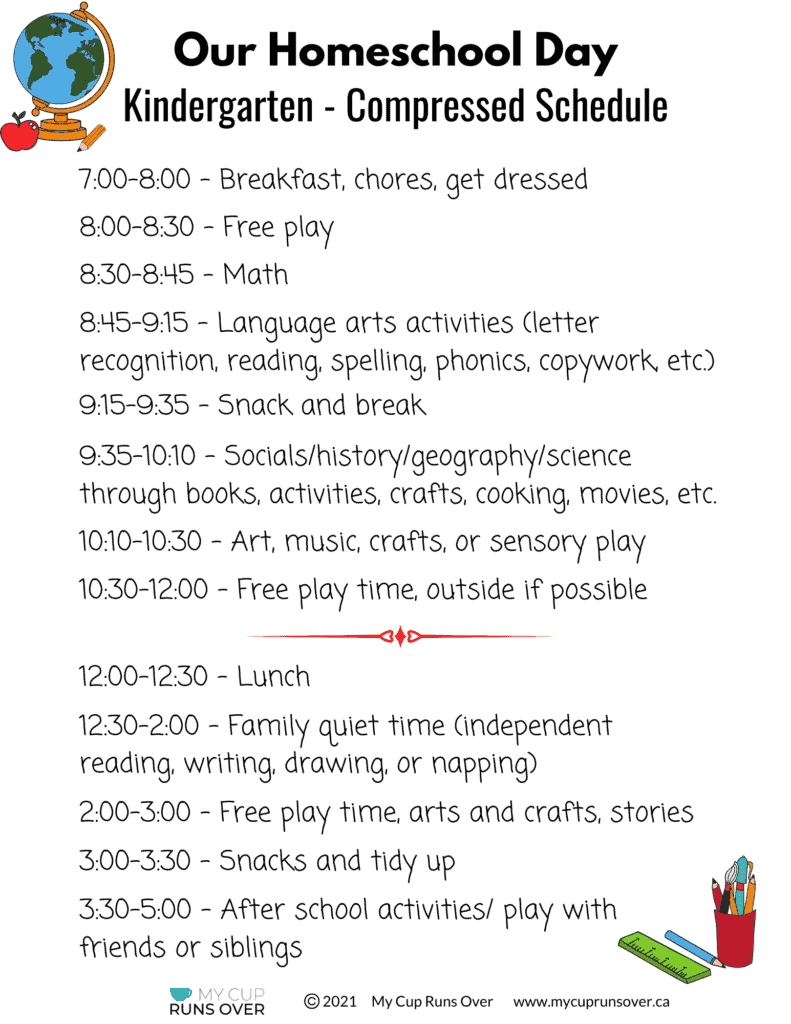
Kindergarten Daily Schedule Template
Click below to open your own copy of the kindergarten daily schedule template in Google Sheets.
I really hope that one of these kindergarten homeschool schedules works for you and that you have an awesome first year of homeschooling.
I’d love to hear from you. What kind of kindergarten schedule works best for you? What resources are you looking for?
Leave a comment below or send me a DM on Instagram for a faster response. I’d love to connect.

Sophie Agbonkhese is a writer, homeschooling mother of four, and a recovering overachiever (who occasionally relapses). She is the founder of My Cup Runs Over, a site dedicated to helping busy women simplify and enrich their lives. When she’s not writing or debugging websites, Sophie spends her time reading, dancing, bullet journaling, reading, gardening, listening to audiobooks, and striving fruitlessly to have a clean house for at least five minutes.

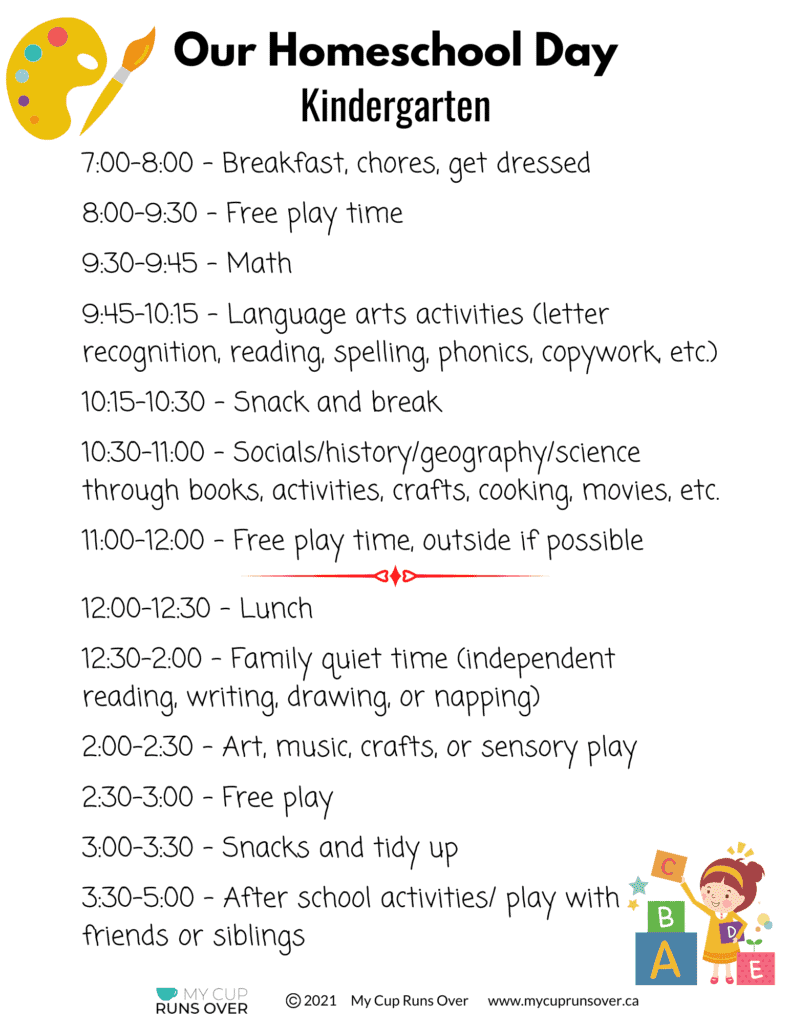
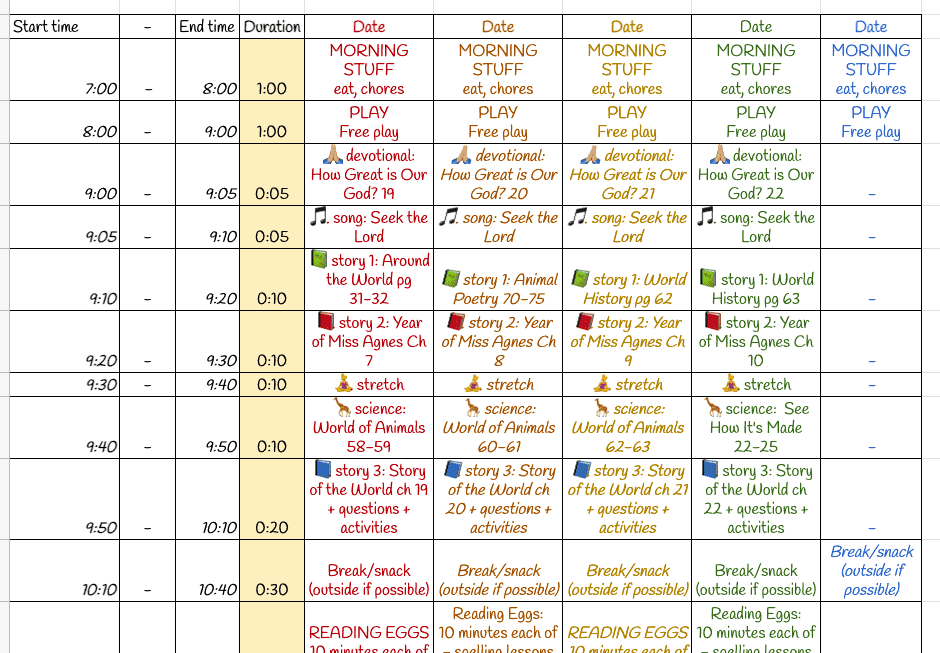
Sarah
Monday 30th of January 2023
Hey I have tried multiple times to edit the schedule in google sheets and it’s only getting me the view only version. What am I doing wrong lol
SOPHIE AGBONKHESE
Tuesday 28th of February 2023
Hi Sarah. I have updated the link so that it will automatically prompt you to make your own copy of the spreadsheet, which you'll be able to edit. Here's the new link as well for your convenience.
SOPHIE AGBONKHESE
Tuesday 28th of February 2023
Let me look into this and get back to you. Sorry for the inconvenience!